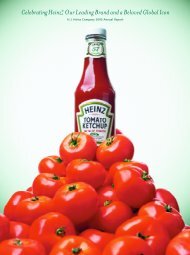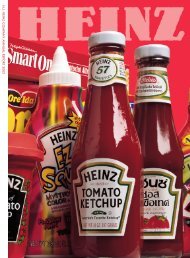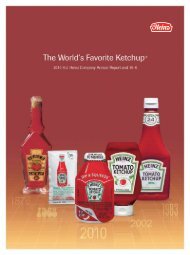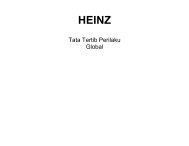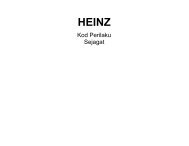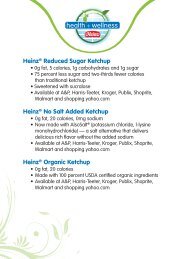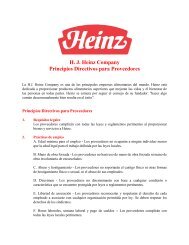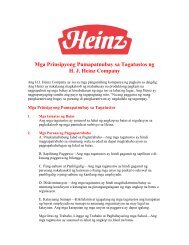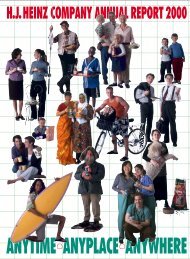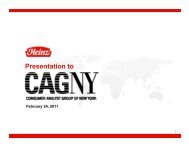Download Annual Report PDF - Heinz
Download Annual Report PDF - Heinz
Download Annual Report PDF - Heinz
Create successful ePaper yourself
Turn your PDF publications into a flip-book with our unique Google optimized e-Paper software.
outstanding trade promotions, making adjustments where appropriate to reflect changes in<br />
estimates. Settlement of these liabilities typically occurs in subsequent periods primarily through<br />
an authorization process for deductions taken by a customer from amounts otherwise due to the<br />
Company. As a result, the ultimate cost of a trade promotion program is dependent on the relative<br />
success of the events and the actions and level of deductions taken by the Company’s customers for<br />
amounts they consider due to them. Final determination of the permissible deductions may take<br />
extended periods of time and could have a significant impact on the Company’s results of operations<br />
depending on how actual results of the programs compare to original estimates.<br />
We offer coupons to consumers in the normal course of our business. Expenses associated with<br />
this activity, which we refer to as coupon redemption costs, are accrued in the period in which the<br />
coupons are offered. The initial estimates made for each coupon offering are based upon historical<br />
redemption experience rates for similar products or coupon amounts. We perform monthly<br />
evaluations of outstanding coupon accruals that compare actual redemption rates to the original<br />
estimates. We review the assumptions used in the valuation of the estimates and determine an<br />
appropriate accrual amount. Adjustments to our initial accrual may be required if actual redemption<br />
rates vary from estimated redemption rates.<br />
Investments and Long-lived Assets, including Property, Plant and Equipment—Investments and<br />
long-lived assets are recorded at their respective cost basis on the date of acquisition. Buildings,<br />
equipment and leasehold improvements are depreciated on a straight-line basis over the estimated<br />
useful life of such assets. The Company reviews investments and long-lived assets, including<br />
intangibles with finite useful lives, and property, plant and equipment, whenever circumstances<br />
change such that the indicated recorded value of an asset may not be recoverable or has suffered an<br />
other-than-temporary impairment. Factors that may affect recoverability include changes in<br />
planned use of equipment or software, the closing of facilities and changes in the underlying<br />
financial strength of investments. The estimate of current value requires significant management<br />
judgment and requires assumptions that can include: future volume trends and revenue and expense<br />
growth rates developed in connection with the Company’s internal projections and annual operating<br />
plans, and in addition, external factors such as changes in macroeconomic trends. As each is<br />
management’s best estimate on then available information, resulting estimates may differ from<br />
actual cash flows and estimated fair values. When the carrying value of the asset exceeds the future<br />
undiscounted cash flows, an impairment is indicated and the asset is written down to its fair value.<br />
Goodwill and Indefinite-Lived Intangibles—Carrying values of goodwill and intangible assets<br />
with indefinite lives are reviewed for impairment at least annually, or when circumstances indicate<br />
that a possible impairment may exist. Indicators such as unexpected adverse economic factors,<br />
unanticipated technological change or competitive activities, decline in expected cash flows, slower<br />
growth rates, loss of key personnel, and acts by governments and courts, may signal that an asset has<br />
become impaired.<br />
All goodwill is assigned to reporting units, which are primarily one level below our operating<br />
segments. Goodwill is assigned to the reporting unit that benefits from the cash flows arising from<br />
each business combination. We perform our impairment tests of goodwill at the reporting unit level.<br />
The Company has 19 reporting units globally that have assigned goodwill and are thus required to be<br />
tested for impairment.<br />
The Company’s estimates of fair value when testing for impairment of both goodwill and<br />
intangible assets with indefinite lives is based on a discounted cash flow model as management<br />
believes forecasted cash flows are the best indicator of fair value. A number of significant<br />
assumptions and estimates are involved in the application of the discounted cash flow model,<br />
including future volume trends, revenue and expense growth rates, terminal growth rates,<br />
weighted-average cost of capital, tax rates, capital spending and working capital changes. The<br />
assumptions used in the models were determined utilizing historical data, current and anticipated<br />
market conditions, product category growth rates, management plans, and market comparables.<br />
32



